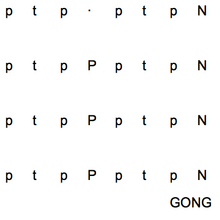
Colotomy is an Indonesian description of the rhythmic and metric patterns of gamelan music. It refers to the use of specific instruments to mark off nested time intervals, or the process of dividing rhythmic time into such nested cycles. In the gamelan, this is usually done by gongs of various size: the kempyang, ketuk, kempul, kenong, gong suwukan, and gong ageng. The fast-playing instruments, kempyang and ketuk, keep a regular beat. The larger gongs group together these hits into larger groupings, playing once per each grouping. The largest gong, the gong ageng, represents the largest time cycle and generally indicates that that section will be repeated, or the piece will move on to a new section.
The details of the rhythmic patterns depend on the colotomic structure (Javanese: bentuk), also known as gendhing structure. There are a number of different structures, which differ greatly in length and complexity; however, all of them have some colotomic characteristics.
In the gamelan, the instruments which articulate this structure are sometimes called the colotomic instruments (also interpunctuating instruments or structural instruments, while Lindsay refers to them as "phrase-making instruments"[2]). The Javanese names for these instruments are onomatopoeic, with the relative resonance of the words gong, kempul, kenong, and ketuk being comparable to that of the instruments they name.[3] In the system of cipher gamelan notation (kepatihan notation), the colotomic parts are notated as diacritical marks on the numbers used to show the core melody (balungan).
- ^ Lindsay, Jennifer (1992). Javanese Gamelan, p.48-49. ISBN 0-19-588582-1.
- ^ Lindsay (1992), p.10.
- ^ Lindsay (1992), p.14.